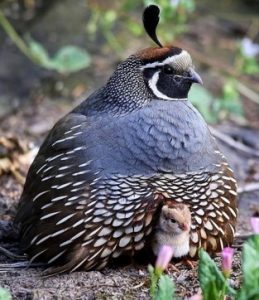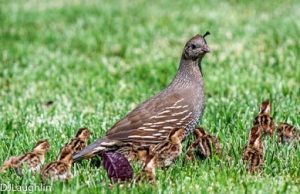Support Us
Since 1979 more than 140,000 animals have been treated by Wildlife Rescue.
Thanks to the support of individuals like you, Wildlife Rescue can provide a lifeline for animals in distress.
Recently, a nest containing two California Quail babies was found in the interior region of Osoyoos, BC, where Quail populations thrive. A concerned Samaritan rescued the possible orphans from their nest with no sign of parents nearby. Luckily, the finder kept the babies warm overnight, bringing them to Wildlife Rescue the next day for care.

California Quail have a collection of overlapping feathers on top of their small heads that curl into a U shape. They have a short neck, wide wings, and a square tail. Their round bellies are covered with gray, white, and rust-colored feathers. You can distinguish the female from the male California quail by the coloring on their head. Females have brown and males’ heads are black with white stripes. Female California quail have brown heads.
California Quail are rare in the lower mainland. In 2019 Wildlife Rescue only provided care to three California Quail related to predator attacks and possible orphans. With nests in secluded areas in the ground near tall grass, tree trunks, and rocks, Quail can easily be injured by both predators and curious humans.
The female California Quail hides her nest on the ground among the grasses or at the base of shrubs and trees. The nest is usually formed by using stems and grasses and then carefully placed near vegetation or rocks for protection.
California Quail spend most of their time on the ground, though they will burst into a flight to avoid predators. They travel in small groups called coveys until spring when they pair off for the breeding season. Females lay white eggs with brown markings. Some nests have as many as 28 eggs, because females “egg dump,” which means they lay eggs in other bird’s nests.

Road to Recovery for Baby Quail
Staff and volunteers are providing much-needed warmth and a nutritional diet of seeds, chick mix, and insects to ensure these babies can make it into adulthood and safely return home. The baby Quail will need to develop their feathers and be able to take flight before they are set for their pre-release assessment in the next few weeks.
Tips to help vulnerable baby Quail and bird chicks
The height of birds nesting season occurs from March to June. Human respect during this period is essential to maintain healthy populations. You can learn to co-exist with vulnerable wildlife by:
If you see a bird that has exposed bone or blood, no feathers, bugs, or insects covering it or a bird that is sleeping, human intervention is required. Please contact our Support Centre for assistance.